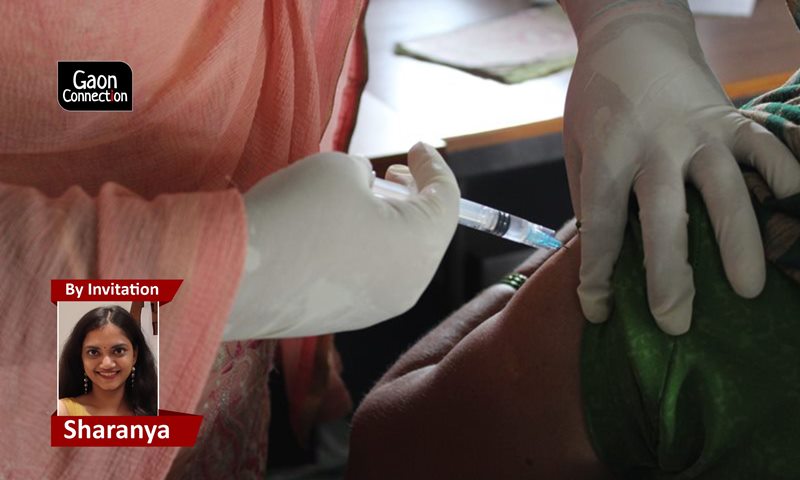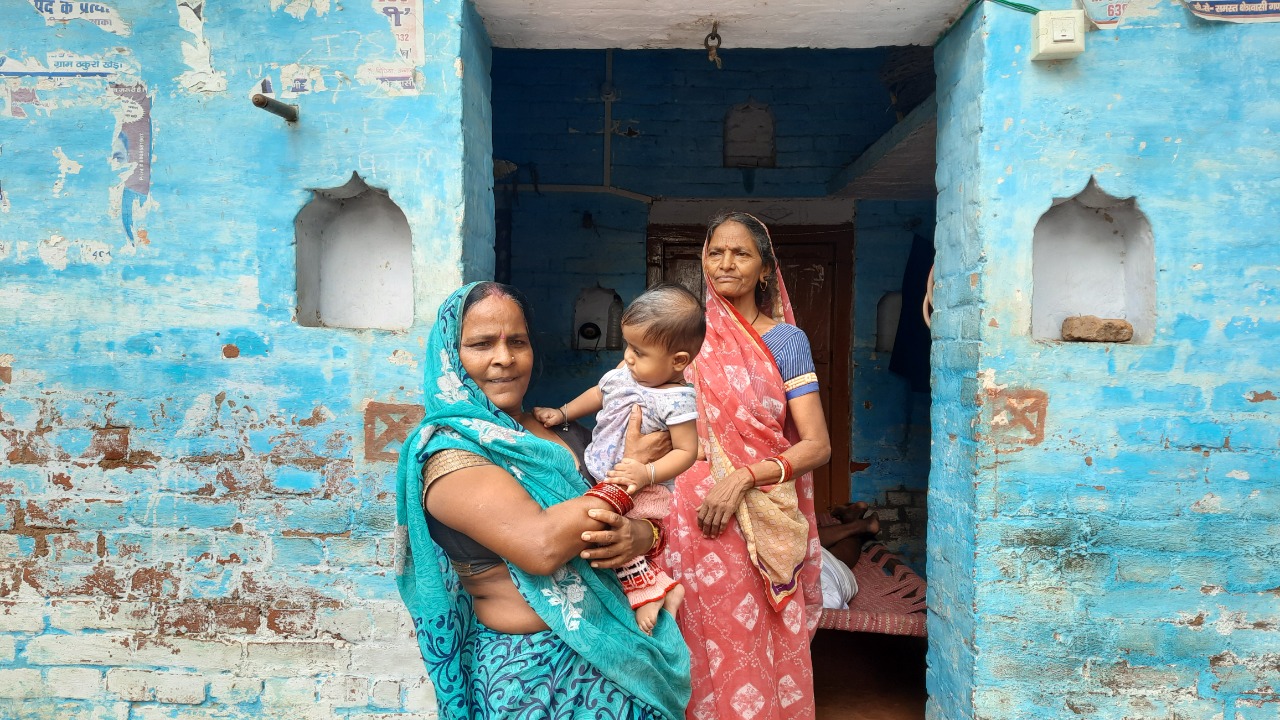Vaccine hesitancy cannot be dealt with mandatory vaccination
Threats and coercion cannot dwindle vaccine hesitancy. People are getting vaccinated out of “fear” of discontinuation of social security schemes and not out of fear of the virus. It is important to spread awareness around vaccines and to win the trust of the community.


Lack of awareness of COVID-19 still exists in the villages. Photo: Shruty Yadav
A few months back, the prevalence of vaccine hesitancy in rural areas was all over the news and social media platforms. Lack of trust in the public healthcare system, misinformation, and rumours were considered to be major challenges to getting people of rural areas vaccinated. The existence of the virus was negated and vaccine wastage was another pertaining challenge.
But after a short while, the trend changed, rural areas started to do fairly better and a good number of people turned up at the vaccine centres. However, another problem came into the picture – the number of people mostly far exceeded the doses of vaccine allotted at the centres.
What actually happened in a month or two that flipped the picture in the rural areas? Did the government actually tackle vaccine hesitancy?
An increase in inoculation and vaccine hesitancy is mutually exclusive
At the peak of the second wave, it was difficult to convince people of rural areas of Sihawal block in Sidhi district, Madhya Pradesh to get inoculated and there was a visible shortage of doses allotted to any vaccine centre. But things started to change and a good number of people had to be turned away due to the shortage of vaccines.
On average, a vaccine centre was allotted only 200-300 doses. Raju*, traveled 15 kilometres along with his elderly father to get him vaccinated. Neither of them nor anyone at the centre was following COVID-appropriate behaviour or distancing protocols. Guidelines about physical distancing, gatherings, and wearing a mask are flouted openly at the centre and in the villages.
The vaccine centres were crowded and it was difficult for hospital staff and ASHA [Accredited Social Health Activist] workers to manage the centre. One of the workers shared, how due to a slow internet connection it was difficult to do on-spot registration, and they had to put in extra hours to get the data entered into the CoWin app.
Rama Singh*, an active member of one of the self-help groups in one of the villages, was apprehensive about getting inoculated before. During a discussion in the month of June, she was reluctant to get vaccinated and believed that vaccinations are designed not to eradicate the virus but the tribal population. After a few months, she along with many others got their first jab. Although, one would never find them adhering to COVID-appropriate behaviour guidelines.
Youngsters in their early 20s got their jabs only to be able to travel to other states for work. One of the women shared how her son had to wait in line to get his first jab. More than getting vaccinated he required the certificate before joining a factory in Maharashtra.
Although there is no written notice issued by a panchayat, there is a rumour in the village that public distribution system (PDS) ration would be discontinued for the unvaccinated people and children would not be admitted to the school.
One of the members of the panchayat believed these threats are important to ensure villagers get vaccinated. Similarly, diktat in another district in Madhya Pradesh was issued by the panchayat which showed a positive increase in inoculation.
Also Read: No vaccination, no rations: Madhya Pradesh ‘boosts’ vaccination campaign?
But, threats, forces, and coercion cannot dwindle vaccine hesitancy. People are getting vaccinated out of “fear” of discontinuation of social security schemes and not, out of fear of viruses. Few women still believe vaccination can lead to infertility in men and women. Lack of awareness of COVID-19 still exists in the village. Any deaths due to vaccination of any elderly are still believed to be due to the vaccine.
Winning the trust, not coercion
Least to say, the increase in vaccination in rural areas and decrease in hesitancy is a false equivalence. A culture of fear would not reduce hesitancy rather would increase it. In the future, if we are faced with a deadly and raging pandemic again, probably people would be hesitant again to get vaccinated.
Mandatory vaccination can also backfire. Without winning the trust of the community and without providing them scientific logic and reasoning it might not help in the long run. It can lead to forgery of vaccination certificates the way travellers faked RT-PCR reports to enter other states for holidays. Coercion and fear can make people do unimaginable things and can create a black market.
Also Read: Deep inside rural Mithilanchal in Bihar, vaccine hesitancy is alive and well
Further, pandemics and viruses may come again in the future. Therefore, it is important to learn from the past and closely work with the community.
During the first way of COVID-19, the exodus of migrant workers left a deep scar in the mind of people. It is important to learn from the first wave and second wave of COVID-19 to tackle the third wave. And, to fight pandemics in the future, it is important to adopt a bottom-up approach.

Awareness, awareness, and awareness
It is important to spread awareness on vaccination and the way it has the potential to eradicate the deadliest of diseases. During the second wave, civil society organisations, government, and voluntary organisations came together ferociously to spread awareness.
The right approach would be to keep disseminating awareness on the vaccine and COVID-appropriate behaviour till a large population is fully vaccinated. In addition, we need to be honest with the side-effects of vaccines, possible symptoms, and efficacy of vaccines with the people.
Also Read: By roping in religious leaders and young influencers, Unnao in UP is addressing vaccine hesitancy
To get rid of vaccine hesitancy it is important to actively involve religious leaders, traditional healers, panchayats, self-help group (SHG) members.
Incentive-based approach
The World Health Organization has stressed the importance of urgent scaling of public healthcare system to arrest the spread of a new variant of SARS-CoV-2 called Omicron. They have warned of an increased risk of re-infection with Omicron. It is also been predicted that the third wave of COVID can arrive early next year.
Therefore, it is important to spread awareness around vaccines and to win the trust of the community. The awareness-building should be around COVID appropriate behaviour along with precautionary measures to be kept in mind to arrest the spread of the COVID. The need of the hour even today is to tackle vaccine hesitancy and that cannot be ensured by mandatory or forceful vaccination.
The incentive-based approach and conducting inoculation by setting up camp in the villages can also be explored. One of the reasons daily wage workers do not want to get vaccinated it to avoid prolonged after effects of vaccination. Therefore, providing them an incentive in the form of cash can be an option to overcome the resistance.
Some names in the article have been changed on request.
Sharanya is a development professional and works with PRADAN, a grassroots NGO. She is currently based out of Madhya Pradesh. Views are personal.

